Want to enjoy juicy and plump berries with floral notes in your urban home? Then what’d be better than Growing Raspberry in Pots and Containers?
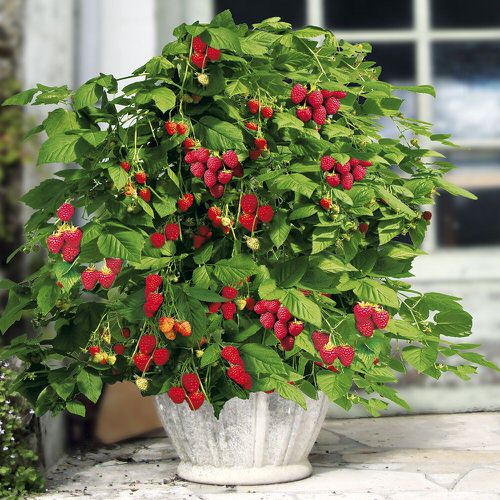
Growing Raspberry in Pots could be your best option if you live in an apartment or don’t have a big garden. The plant is easy to grow, and there’s nothing like munching on fresh and organic, homegrown raspberries!
Botanical Name: Rubus idaeus
Common Name: Red Raspberry, European Red Raspberry, Rubus
Native: Europe and northern Asia
Hardiness Zones: 4-8
Check out Best Berries to Grow in Containers here
About Raspberries
Raspberries are not individual berries but a cluster of several tiny fruits, known as drupelets with a single seed, unlike other berries. These ancient berries were first cultivated in England and France in the 1600s for human consumption.
These delicious fruits are relative to roses and can be enjoyed on their own or even baked into desserts, cakes, pies, and other dishes – they also boast many health benefits.
Raspberries are one of the quick-growing fruits, check out a few more here
Raspberry Appearance and Taste
Raspberries come in various shades ranging from red, golden, blue, yellow, black, or purple! With such a wide variety of over 200 species, each raspberry is known for its distinct characteristics like color, flavor, juiciness, texture, appearance, and more. These berries are marked for their sweet flavor and fragrance with a subtle tart overtone.
Best Raspberry Varieties For Pots
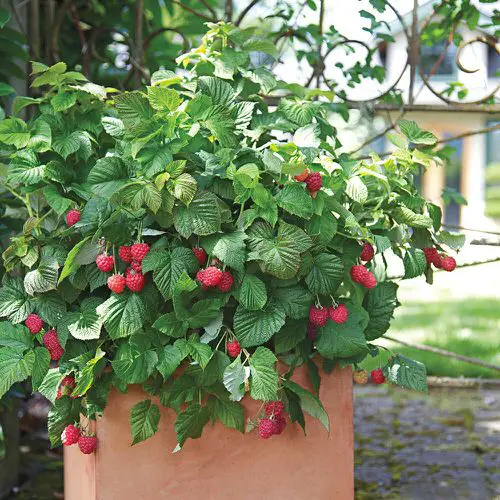
As raspberry bushes are not very tall, you can try almost any cultivar. The most popular types are the American Red Raspberry, Black Raspberry, Snow Raspberry, Flowering Raspberry, and Asian Raspberry, to name a few. Here are a few top choices for compact varieties that are best suitable for smaller containers:
1. Heritage Raspberry Bush
USDA Zones: 4-8
This evergreen shrub, with large berries, is the most common red variety that grows well in containers without any support and can grow up to 5-6 feet tall.
2. Red Latham
USDA Zone: 3-10
A self-pollinating summer fruiting variety–it produces shining red berries from late June to mid-July. This cultivar is convenient for pots because of its compact growth.
3. Raspberry Shortcake
USDA Zones: 5-9
This bush was developed mainly for containers. It has a round, dense, compact, thornless appearance. It is easy to harvest and self-pollinating.
4. Anne
USDA Zones: 4-9
Another self-pollinating evergreen variety that bears pale yellow-colored lovely berries that are also cold-hardy. The new canes produce fruits in the first year’s fall and the second year’s summer.
5. Glencoe Purple Thornless Florican Raspberry
USDA Zones: 4-8
It is a crossbreed between red and black raspberry plants, giving it a lovely purple hue and an excellent flavor. With its non-spreading and bushy appearance, it is an ideal choice for containers.
Best Raspberry Planting Time
The best time to plant raspberry is spring, more specifically–early spring. However, you can also plant it in late fall to early winter. If the summer is mild in your region, you can start growing raspberries in pots at that time too.
Generally, the bare root raspberry plants are best sold online and at garden centers during the dormant months (For example–December and January). You should plant them as soon as you get them.
If you’re new to growing plants or want quick results, it’s better to buy potted raspberry plants available in nurseries and garden centers, almost year round. Just check out for signs of diseases and pest problems before you bring them.
Right Container Size for Raspberry
As they are strong growers growing them in 16-20 inches containers is best. This will allow the plant enough space to spread out and also offer all the room to put stakes for support. Please make sure the pots have drainage holes to allow excess water to drain out.
Requirements for Growing Raspberry in Pots
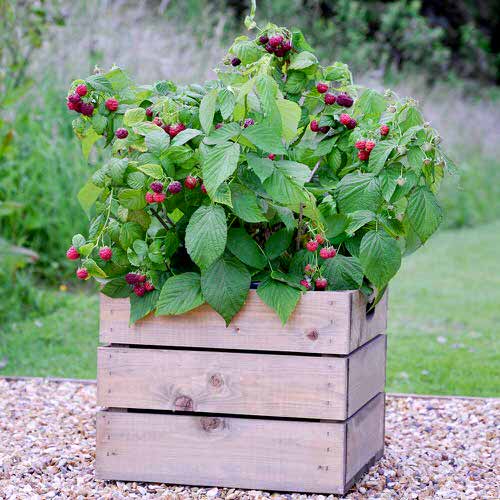
Location
The berries need daylight in abundance, and the container should be placed on a spot that receives 6-8 hours of direct sunlight every day and the spot must not be too windy as well. It can thrive in partial light, but it won’t fruit heavily.
However, if you’re growing it in moderately warm climates (USDA Zones 8 to 10), the bush will perform better in part sun.
Soil
As long as the potting soil has ample organic matter, the plant will do well. For best berries, you will have to keep three things in mind–First, the soil needs to be slightly acidic (pH 6.2 to 6.7), second, it must be rich, and third, it has to be well-draining.
For the best growth, a mixture of quality potting mix, along with compost or aged manure and humus will do wonders. You can also use peat moss and perlite. If the soil is heavy, add some sand, aged manure, perlite, and peat moss to it to amend it or buy a commercial.
Watering
For best fruits, it is essential that you keep the plants well-watered while making sure that you are not making the soil soggy. If you have placed the container on a bright balcony or patio, you will have to water it more frequently.
The best method to follow is to check the topsoil, once every 2 days, to see if it’s dry or wet. Water the plant till it seeps out from the bottom hole when the topsoil dries. Also, remember to reduce watering in winter!
Temperature
Raspberries do best in temperatures range of 60-80 F or 15-26 C during the growing season.
Raspberry Plant Care
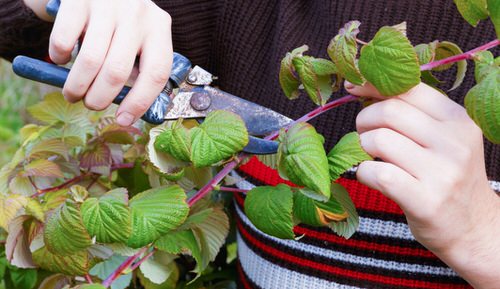
Fertilizer
A monthly dose of balanced liquid fertilizer such as 16–16–16 or 20–20–20, will make sure the plant stays healthy. Just make sure that you refer to the label for dosage and instructions. You can also apply cottonseed meal, feather meal, bone meal, blood meal, and fish emulsion.
Avoid using fresh manure products on the berries as they might pose a potential health risk. Also, raspberries are prone to boron deficiency, so check out symptoms like stunted growth and poor production.
Pruning
Some varieties can quickly grow as tall as 5-6 feet in height in a container, and you might need to give proper trimming to prune them back. It is best advised to prune in late winter, in February. Cut back any damaged canes mid-season to give proper shape and height. Also, prune the plant after harvest to prepare it for winter.
It is essential that you snip away the parts of the canes that had fruits in the previous year. This will promote the plant to grow new canes in the following summer for fruits. However, this step is optional and you can choose not to do it if you want.
Pollination
Most cultivars are self-pollinating so you don’t have to worry about it but a welcome a few visits from pollinators like bees, this will improve your harvest.
Support
It is essential that you provide the plant with the right support using bamboo sticks or wires. Without them, the stems will droop, inviting pests and diseases while making harvesting a difficult job.
You can stretch a wire on both sides of the plant and tie the stems to make them stand erect while giving them support with a bamboo stick and twine.
Pests and Diseases
It will help if you keep an eye on aphids, cane borers, raspberry beetle or fruit worms, and even local birds from causing any damage.
To avoid these potential problems, either go for disease-free raspberry varieties or use insecticidal soap to get rid of pets. Also, make sure that the plant is properly ventilated, adequately watered, and not becoming too dense to avoid diseases.
It is also a good idea to sprinkle water on the foliage in hot months to keep the mite population in check.
Harvesting and Storing Raspberries
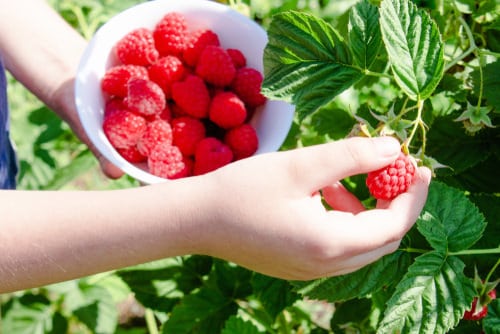
Early morning or late evening is the best time to pick them up as the temperature is cool and this will help them stay longer while being refrigerated. Pull the bunch gently from the plant. You can also use a shear to make a clean cut.
You can keep them for as long as 2-3 months in ziplock bags in a refrigerator to use in cakes, sauces, or drinks. If you want to eat them, there’s nothing like fresh raspberries!
Raspberry Benefits

Raspberries are low in calories and rich in vitamins, minerals, fiber, and antioxidants. They also help fight high blood pressure, obesity, arthritis, and constipation and helps in maintaining a healthy digestive tract with regular bowel movements.
The red berries have Anthocyanins, that promote youthful skin with a spotless, blemish-free complexion.


